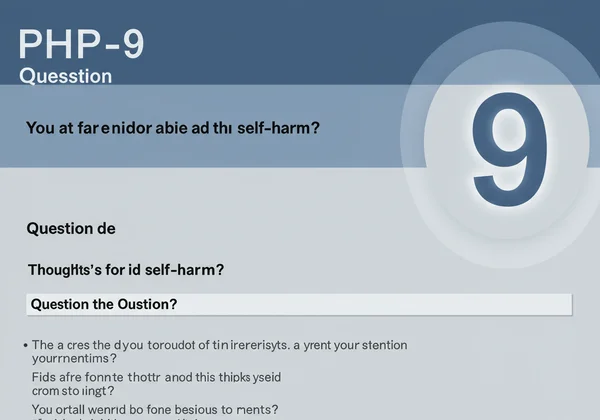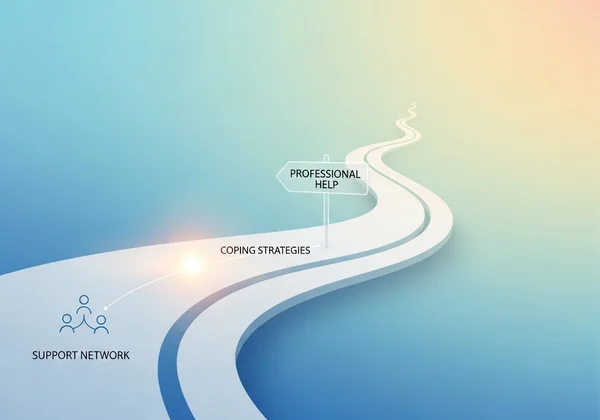PHQ9 Question 9: Self-Harm Thoughts & Crisis Support
Facing thoughts of self-harm takes immense courage and strength. If you've encountered the final question on the Patient Health Questionnaire-9 (PHQ-9) and recognized yourself in those words, please know you are not alone, and there is immediate, compassionate help available. The purpose of the phq9 is to provide a snapshot of your emotional health, but its most critical function is to identify when you need support the most. So, what is phq 9 and how can understanding its most serious question be the first step toward safety and healing? This guide is here to walk you through what PHQ9 Question 9 means, the immediate steps you can take to find safety, and how to build a path toward sustained well-being. Taking the first step towards feeling better often means understanding your current emotional state. Our confidential online tool can help you do that right now.
What is PHQ9 Question 9, and Why is it So Important?
The PHQ9 question 9 is the most critical item in the entire screening tool because it directly addresses thoughts of self-harm or suicide. While the first eight questions assess symptoms like low mood, fatigue, and loss of interest, the ninth question serves as a crucial safety check. It is a signal that requires immediate attention and care, not because it's a point of judgment, but because it’s an indicator of profound pain that no one should have to carry by themselves. Understanding this question is vital for anyone taking the test or supporting someone who is.

Deciphering the Ninth Question on the PHQ9 Test
The Ninth Question on the PHQ9 Test asks: "Over the last two weeks, how often have you been bothered by thoughts that you would be better off dead, or of hurting yourself in some way?" The response options range from "Not at all" to "Nearly every day." A score above zero on this question is a significant clinical flag. It indicates the presence of passive or active suicidal ideation, which is a serious symptom of depression and other mental health challenges. It’s a brave admission that can open the door to life-saving support.
The Clinical Significance of Self-Harm Ideation Screening
From a professional standpoint, the value of Self-Harm Ideation Screening cannot be overstated. This single question provides healthcare providers with a direct and standardized way to open a conversation about safety. A positive answer prompts a provider to conduct a more thorough risk assessment to understand the nature, frequency, and intensity of these thoughts. The Clinical Significance lies in its power to prevent tragedy. It transforms a private struggle into an acknowledged concern that can be addressed with a collaborative safety plan, therapy, and other supportive resources. Taking the assessment can be a powerful first step to understanding your results and sharing them with a professional.
Immediate Help: Steps to Take When Thoughts Arise
If you are experiencing thoughts of self-harm, your safety is the number one priority. The feeling of crisis can be overwhelming, but there are clear, immediate steps you can take to get through this moment. Remember, these thoughts are symptoms, not your identity, and they can be managed with the right immediate help. You do not have to act on them.
Connecting with Lifesaving Crisis Hotlines & Services
Your first and most important action is to reach out for professional help. Do not wait. Crisis Hotlines are free, confidential, and available 24/7, staffed by trained counselors ready to listen and support you.
-
Emergency Services: If you are in immediate danger of harming yourself, call 911 or your local emergency number right away.
-
National Crisis Hotlines: In the U.S., you can call or text 988 to connect with the Suicide & Crisis Lifeline. Many countries have similar dedicated, easy-to-remember numbers.
-
Crisis Text Lines: If talking on the phone feels too difficult, services like the Crisis Text Line (text HOME to 741741 in the US and Canada) allow you to communicate with a counselor via text.

Reaching Out to Your Support Network
While professional help is essential, your personal Support Network can provide immediate comfort and accountability. Reach out to a trusted family member, a close friend, a spiritual advisor, or a mentor. It can be as simple as saying, "I'm having a really hard time right now and I need to talk," or "I'm not feeling safe, can you sit with me?" Allowing someone you trust to know what you're going through can lessen the burden of isolation and help keep you safe while you connect with professional resources.
Supporting a Loved One with Self-Harm Concerns
Discovering that a friend or family member is struggling with thoughts of self-harm can be frightening. As a caregiver, your role is to provide compassionate crisis support and help guide them toward professional care. Your calm, supportive presence can make a significant difference. You can gently suggest they start an assessment to help them articulate their feelings.
How to Have a Compassionate Conversation
Starting a Compassionate Conversation is key. Find a private, comfortable space and approach the topic with empathy and without judgment. Use "I" statements to express your concern, such as, "I've noticed you seem really down lately, and I'm worried about you." Listen more than you speak. Validate their pain by saying things like, "That sounds incredibly difficult," or "Thank you for trusting me enough to tell me this." Avoid trying to "fix" the problem and instead focus on being a safe, supportive presence.

Guiding Them Towards Professional Intervention
Your ultimate goal is to help your loved one connect with Professional Intervention. You can help them find contact information for therapists or crisis lines. Offer practical support, like saying, "I can sit with you while you make the call," or "I can help you look for a local counselor." It's important to reinforce that the PHQ-9 is a screening tool, not a diagnosis, and that a professional can provide the expert guidance they need for a path forward.
Beyond the Crisis: Sustaining Mental Well-being & Prevention
Getting through a moment of crisis is a monumental victory. The next chapter is about building a life of sustained mental well-being and focusing on suicide prevention through proactive strategies. This involves creating systems of support and care that help you manage your mental health for the long term. Sustaining mental well-being is an ongoing journey of self-compassion and care. Tools like a regular emotional checkup can be valuable aids along the way.
Building a Personal Safety Plan for Future Support
A Personal Safety Plan is a proactive tool you create with a therapist or trusted support person. It's a written document that outlines what you will do when you start to feel distressed or have thoughts of self-harm. It typically includes:
-
Warning Signs: Identifying your personal triggers and early warning signs of a crisis.
-
Coping Strategies: Listing calming activities you can do on your own, like deep breathing, listening to music, or going for a walk.
-
Social Support: People and places you can connect with for distraction and support.
-
Professional Contacts: Listing your therapist, doctor, and crisis hotline numbers.
-
Making the Environment Safe: Steps to remove or secure any means of self-harm.

The Role of Ongoing Professional Mental Health Care
Just like physical health, mental health requires consistent attention. Ongoing Professional Mental Health Care, such as regular therapy or counseling, is fundamental to long-term recovery. It provides a safe space to process underlying issues, learn new coping skills, and monitor your progress. A therapist can help you understand your depression, manage your symptoms, and build resilience against future crises.
Taking the Next Brave Step Towards Healing and Support
Encountering PHQ9 Question 9 is a critical moment that signals a need for immediate care and compassion. It is not a sign of weakness but an indicator of deep emotional pain that deserves to be heard and healed. Remember, help is always available, and you are not alone on this journey. These thoughts do not have to be your reality.
The PHQ-9 is a valuable tool for starting a conversation, but it is just that—a start. We encourage you to use your results as a bridge to connect with a healthcare professional. Take the next brave step today by using our free PHQ9 assessment to better understand your emotional state, and please, reach out for the professional support you deserve. Your life is invaluable.
Frequently Asked Questions About PHQ9 & Self-Harm Support
Can the PHQ9 test diagnose self-harm risk or depression?
No, the PHQ9 test cannot diagnose any condition. It is a highly effective screening tool designed to identify the presence and severity of depressive symptoms. A high score, especially on question 9, strongly indicates that a professional evaluation by a doctor or mental health expert is necessary to make an accurate diagnosis and create a treatment plan.
How reliable is PHQ9 Question 9 for assessing suicidal ideation?
PHQ9 Question 9 is a very reliable indicator for suicidal ideation. It is a clinically validated question used worldwide by healthcare professionals as a critical first step in risk assessment. Any score other than "Not at all" is a sign that the individual needs to be engaged in a direct conversation about their safety.
What should I do if my friend or family member scores high on PHQ9 Question 9?
You should take it very seriously. Your first priority is to ensure they are safe. Have a compassionate conversation, listen without judgment, and strongly encourage them to seek immediate professional help, such as calling a crisis hotline or their doctor. Offer to help them make the call or find resources. Do not leave them alone if you believe they are in immediate danger.
How often should the PHQ9 be taken if I am experiencing self-harm thoughts?
This should be determined in collaboration with a mental health professional. If you are actively experiencing these thoughts, immediate crisis support is more important than repeat testing. A therapist or doctor may use the PHQ-9 periodically to monitor your progress over time, but its frequency is a matter of clinical judgment. You can use a tool like the PHQ-9 online test as a check-in between appointments, as advised by your provider.